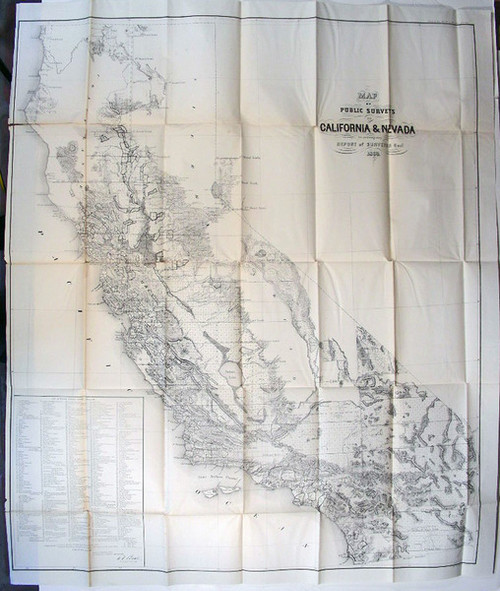Smith, William; Geological Map of Norfolk. By W. Smith, Mineral Surveyor. London: J.Cary Engraver & Map seller, No.181 Strand Jan.,1819.
This rare geological map remains unfolded as issued. Within the map borders it is bright with very light dust soiling. There is a light marginal stain at the very outer edge of the sheet, well outside the borders and a couple of short marginal tears well outside the border.. Over all in very good condition.
William Smith (1769-1839), was a civil engineer and geologist. Today he is known as the “Father of English Geology”, for creating the first geological map of England and Wales. With the aid and backing of Sir Joseph Banks, in August 1815 Smith’s “Geological Map” of England was finally published. Titled “A Delineation of the Strata of England and Wales, with Part of Scotland”, this was a major work for one person.
As a child, William Smith was interested in the local fossils and began collecting them. He attended a small village school until about age eleven and later self-taught himself the basic methods of surveying. Smith trained under Edward Webb, a master land surveyor and learned how to measure and value land. As Edward Webb’s assistant, Smith surveyed estates in Somerset and then obtained a position surveying routes for a planned coal canal from Somerset to London in 1794. The canal excavation began in 1795 and Smith discovered that the strata of Somerset could be mapped and he observed that the same types of fossils appeared in the same strata. What was more important, Smith also noticed that the strata of Somerset extended northwards across England and he realized that he could chart the strata on maps using colors to indicate the different strata and their thickness.
Smith realized that there were economic benefits in finding strata with coal iron other minerals or clay, and started traveling England to find commissions to survey lands for minerals using his new method based on strata. His work was not limited to mineral prospecting, but also included building sea defenses, improving harbors and canal surveying.
Smith was always collating information concerning the strata of England and spent his spare time traveling the country to fill in any gaps in his perceived geological map of the country. But he failed to find a publisher for his map. In 1807 the Geological Society of London was founded but even they would not consider publishing Smith’s map. After all, William Smith did not have the proper education or “pedigree”.
After many failures Smith found support and backing from Sir Joseph Banks. In August 1815 his “Geological Map” of England was finally published. Titled “A Delineation of the Strata of England and Wales, with Part of Scotland”. While it was an amazing work for one person, it was not a commercial success. The map comprised fifteen sheets all in all, on a five miles to one inch scale. When the sheets were joined together, the map measured 259cm x 176cm.
Over the next four years after its publication, Smith constantly updated the work as his geological knowledge increased. Financial hardship in 1819 led to him spending almost ten weeks in a debtor’s prison and he was forced to sell his extensive fossil collection and library to help remedy the situation. While Smith was clearing up the matter of debts, he focused on more map detail and went on to produce an excellent set of twenty-one large scale geological county maps from 1819 to 1824. Thus began the publication of what was proposed to be a geological atlas of England and Wales. Each map was published unfolded as a sheet on heavy stock paper. Published in parts over five years, it remained unfinished, containing 21 maps of English counties. All the county maps published contain much more information than was shown on Smith’s large map of 1815, proving that during the intervening years he had done much to increase his knowledge. The maps are based on John Cary’s county maps which are considered some of the finest maps of the 19th century, and are headed ‘By W. Smith, Mineral Surveyor”. John Cary was a famous English cartographer, producing from 1787 what was to become one of the standard references for mapping of England. John Cary produced the engraved plates, marked with Smith’s geology. Once printed, the maps were colored by John Cary’s employees under Smith’s direction. And then published.
The unfinished atlas was published in parts. Part I: Published in 1819, included maps of Norfolk, Kent, Wiltshire, and Sussex. Part II: Published in late 1819, included Gloucestershire, Berkshire, Surrey, and Suffolk. Remaining parts were published in 1820, 1821, and 1822, with the final volume in 1824.
The sheets measure approximately 580 mm by 710 mm with the map contained within an engraved and colored border measuring 480 mm by 530 mm. Each sheet carries, within an oval, shadowed, cartouche the title: A NEW MAP OF (county name) DIVIDED INTO HUNDREDS, EXHIBITING Its Roads, Rivers, Parks, &c. By JOHN CARY Engraver, [year printed]. Along the top of each map is the title: GEOLOGICAL MAP OF [county name], by W.SMITH, Mineral Surveyor, and at the bottom: London. Published by J.Cary Engraver & Mapseller and his address, either No.181 Strand or No.86 St. James’s Str.[Cary moved here in 1820 after a fire at 181 Strand].
Unlike Smith’s 1815 map “A Delineation of the Strata of England and Wales with part of Scotland”, the county maps, do not contain a stratigraphical colored key. The strata are identified by name and number with colored boxes around the county boundary adjacent to their outcrop. The colors used are close to those on the 1815 map and the outcrop shading is the same. At the base of the map is a notation that “The numbers attached to the description of each Stratum, refer to the Geological Table of British Organized Fossils, which may be had of the Publisher, Price 1s 6d”




















